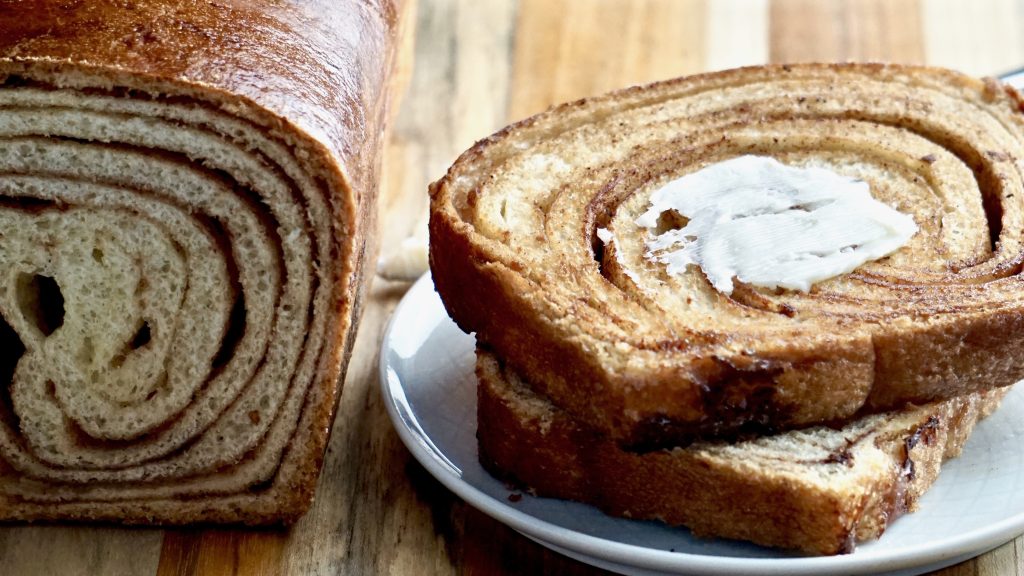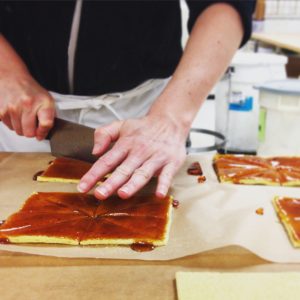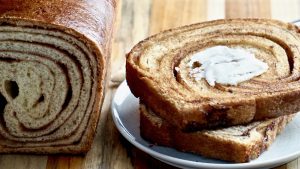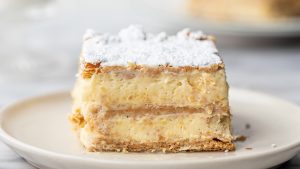
With several trips to Hungary and over a decade of hard work in their professional kitchens, our baking pals at Zingerman’s Bakehouse have been recreating many Hungarian delicacies since 2011. From savory strudel to Somodi Kalács, there’s something for everyone. You may not be as familiar with Esterházy Torta as a pain au chocolat, but it may very well become your new fave. Consider this a crash course on all the incredible Hungarian treats the Deli gets from the Bakehouse!
Why Hungary?

Hungarian food goes way back; Hungary as we know it was founded by the Magyars in the 9th century, which means there’s been ample time for Hungary to cycle through different rulers and accumulate a vast culture, especially when it comes to cuisine! From the Ottoman Turks in the 16th century to the Hapsburg dynasty from the 17th to 19th century and Communist rule post-World War II, Hungary has had an impressive number of different culinary influences. Hungarian nobility would often invite French and Italian chefs to their royal kitchens as well, expanding their culinary repertoire into the likes of Western Europe.
At the turn of the 20th century, Hungary was bustling with a vibrant coffeehouse culture. All types of folks, from poets to politicians, used coffeehouses as a means to socialize and exchange ideas—and, of course, indulge in delicious baked goods. At the height of the fad, there were 500 coffeehouses throughout Budapest alone. The craze died down after Hungary suffered through two world wars, however, and most of these coffeehouses disappeared by the 1950s. Fortunately a handful have been restored in recent years, and there has been an effort to revive coffeehouse culture in Hungary. Who doesn’t love a good coffeehouse (wink, wink … have you been to our Next Door Café)?
Hungary also has a strong connection to Eastern European Jewry and the same Ashkenazi Jewish food that Zingerman’s takes so much pride in. Hungary once had the largest Jewish population in the continent, which suffered a severe decline as Jewish people throughout Europe hid, fled, or were apprehended and killed during World War II. But just like the coffeehouse culture of the early 20th century, there has been a resurgence of Jewish life and Jewish cooking in Budapest beginning in the 1990s. We are happy to report that Budapest is now once again home to a thriving Jewish community—the largest in Eastern Europe!
What’s On The Menu?
The Bakehouse’s Hungarian delicacies are all seasonal, so give us a call or look online for their availability before you visit.
 Potato Bacon Rétes:
Potato Bacon Rétes:
Rétes is the Hungarian name for what most of the Western world will know as “strudel.” Rétes comes from the Hungarian word réteges, meaning “layered.” Potatoes, like paprika, are not native to Hungary. They were brought from the Western Hemisphere during the Columbian Exchange, a colonial excursion at the end of the 15th and into the 16th century. They became a Hungarian staple when the government ordered people to grow them after famine led to widespread hunger from 1770 to 1772. The rétes from the Bakehouse are made with Nueske’s applewood smoked bacon; the sweet smokiness of the bacon offsets the creamy texture of the perfectly cooked potatoes and the flakiness of that delicious pastry that the Bakehouse staff stretches so incredibly thin. Amy said of the strudel-making process: “The dough is one of those wonders of the baking world that is rewarding to make. It’s like a magic trick!” The Bakehouse also makes rétes with Indian spice, apple, and cabbage with goose fat.
Pogacsa:

Pogácsa are basically perfect little bites of buttery Hungarian baked goodness. It was originally baked in the hot ashes of fireplaces, but the folks at the Bakehouse fortunately have ovens to bake theirs! Made with sour cream, eggs, butter, and the layering of dough, pogácsa are light and tender. In the marvelous, deservedly award-winning cookbook, Zingerman’s Bakehouse, co-author and Bakehouse managing partner Amy Emberling explains that they’re “rich and delicious rolls made in Hungary … eaten at breakfast, for a snack, for appetizers, or to accompany dinner. If you want to make a true Hungarian meal, pogácsa are an essential component.” Depending on where you are and who’s in the kitchen, you’ll find pogácsa with a wide variety of fillings and mix-ins, from potatoes to ground beef to cheese. The Bakehouse’s pogácsa are baked with wonderful fresh dill for a light, fluffy biscuit perfect for cracking open and smothering in butter for a quick and satisfying breakfast.
 Rigó Jancsi:
Rigó Jancsi:
It’s been over a decade now since the Bakehouse first started making Rigó Jancsi. It’s a show-stopping pastry with an equally incredible story. Rigó Jancsi was a Roma musician who was a sultry, headline-grabbing musical performer in Europe in the late 19th century. He fell in love with Clara Ward, a Michigan-born American who boldly abandoned her Belgian-prince husband to run away with Jancsi. The cake was developed by a creative Budapest baker to take commercial advantage of the headlines that followed the scandal. The cake is traditionally a beautiful rectangular torte, covered with dark chocolate ganache, with the name Rigó Jancsi (pronounced “ree-go yon-chee”) written in script across the top. It’s typically two layers of really tender, delicate chocolate sponge cake, sandwiched around a modest layer of chocolate, rum-scented whipped cream, topped off with a very thin, delicate layer of apricot glaze, and then, finally, finished with a thick dark chocolate ganache. This is the perfect dessert to follow up a dinner of chicken paprikash.
Almond Kifli:

The name kifli originally referred to the cookie’s crescent shape as well as to other, related, savory breads of this sort. Some say they predate the croissant! According to Hungarian culinary lore, they were first made to celebrate the freeing of Buda, the historic capital of the Kingdom of Hungary, by an alliance of Russia, Bavaria, and Austria from the Ottoman Turks in 1686. Today, the Bakehouse makes kifli to celebrate Hungarian Month — maybe not as monumental as the freeing of Buda, but we still think it’s pretty cool! The Bakehouse’s kifli are made with ground almonds, flour, butter, sugar, vanilla bean, and vanilla extract as well as powdered sugar. Nibble on a few of these while you sip on espresso and imagine yourself at one of Hungary’s famous coffeehouses. They’re great for dipping, too.

Walnut Beigli:
Beigli is to Hungary as stollen is to Germany; a sign of the winter holidays! Beigli is a yeasted dough rolled up with a filling of crushed walnuts and sugar, subtly enhanced by a bit of lemon, butter, and cream. The outside has a beautiful sheen to it and a unique, slightly mottled, crackly look to its crust. Inside are swirls of a thick walnut-sugar filling. There are a few dried currants in the mix to make the texture and flavor a bit more complex, but it’s the walnuts that are the star of the show. Beigli is believed to be a derivative of Bratislava rolls, a poppyseed-filled crescent pastry in Slovakia and elsewhere in Central Europe. The Bakehouse makes Beigli during the winter holiday season. Every Walnut Beigli comes in a beautiful muslin bag printed with a whimsical design, ready for gifting (for others or yourself!). (This item is only available during the winter holiday season, but the recipe for it is in the Bakehouse cookbook “Zingerman’s Bakehouse”!)
Tokaji Cream Cake:
From the good folks at Auguszt, one of the oldest and most well-known bakeries in Budapest (they opened in 1870 and is now in its fifth generation!), comes the Bakehouse’s recipe for Tokaji (pronounced tow-kai) Cream Cake—cream cake in the style of Tokaj, a wine region in Hungary. It’s one of the richest, creamiest, yet lightest of the Bakehouse’s selection of Hungarian goods, and is one of co-managing partner Amy Emberling’s favorites. The Tokaji Cream Cake is a delicious amalgamation of Hungary’s two most prominent culinary contributions—pastry-making and wine. The Bakehouse enjoyed it so much that they adapted the recipe to come up with an American Hungarian version. The Bakehouse makes the cream filling with the Tokaji wine 5 Puttyonos Aszú, a little sugar, local Guernsey whipping cream, and a touch of gelatin for stability. It’s layered with a very light vanilla chiffon cake and fresh raspberries.

Esterházy Torta:
Developed in honor of Prince Esterházy, Paul III Anton, who lived from the late 18th and into the early 19th century. Esterházy’s cake was exceptionally rich and elegant. It was certainly more luxurious than what an average 18th-century Hungarian would ever have eaten. It became one of the most popular baked goods in Budapest along with Dobos Torta and Rigó Jansci. While Esterházy Torta is still not exactly inexpensive, given all the work and high-quality ingredients that go into it, the Bakehouse’s version is more accessible to the average person than it once was in 18th-century Hungary! Layers of toasted walnut cake filled with a mixture of vanilla bean pastry cream, fresh whipped cream, and more toasted walnuts, decorated with vanilla and dark chocolate poured fondant in a special wave design used specifically for Esterházy cakes.
Dobos Torta:

Dobos Torta is the creation of József Dobos who first developed it in his Budapest bakery back in 1884. Dobos’ family apparently had long roots in the food world, so it was probably not a shock when he opened his pastry shop in 1878 at the age of 29. It was the height of the Austro-Hungarian empire, an era in which the arts, architecture, music, and sciences all bloomed. Over the years, his specialty food shop, which sold everything from caviar to cake, became one of the best in Budapest. The Bakehouse’s Dobos Torta is made of five thin layers of very light vanilla cake, sandwiched around a chocolate buttercream. More buttercream coats its sides, which are then dusted with chocolate crumbles. The rectangular cakes are topped with a thin layer of almost crunchy, slightly chewy, delicious caramel. Between the layers and on the sides is a chocolate buttercream enhanced with a hint of ground espresso. It’s especially delicious with a fresh cup of the Next Door Blend coffee. The Dobos is one of Jaison’s all-time favorites. He says, “It’s beautiful to look at but even more exciting to eat. The complexity of flavor and texture is really special. I really love the harmony of the rich chocolate and espresso flavors. The delicate sponge cake and that beautiful crunchy caramel top make it a true eating adventure!!”
 Somodi Kalács:
Somodi Kalács:
If you’re not yet familiar with it, Somodi Kalács is a particularly tasty cinnamon swirl loaf that’s made in the tradition of the Transylvanian town of Torockó. While this old region of Hungary and Romania is world famous for the rather scary story of Vlad Dracul (better known in popular circles as Dracula), there’s a whole lot more to Transylvanian history, cooking, and culture. Made with organic wheat flour, Michigan honey, fresh eggs, and a sweet, buttery, cinnamon sugar swirl, the smell is amazing. The taste is even better. It makes incredible French toast. Somodi Kalács is a special bake, so keep an eye out on our socials for info about when the Bakehouse is making it!
Krémes:

Krémes (pronounced “krem-esh”) is a popular Hungarian pastry found in practically every pastry shop in Budapest. The Bakehouse’s krémes features pastry cream made with real vanilla bean, lightened with soft meringue, set between three layers of flaky, golden brown, buttery puff pastry, and finally dusted with powdered sugar. When you eat it, the creamy, smooth vanilla filling lusciously oozes out between the pastry layers. Here’s what Hungarian food writer András Szántó has said about the popular pastry: “To know a Hungarian is to know someone who takes dessert very seriously … Nothing embodies this more fully than the krémes: a quivering quadrangle of vanilla crème, sandwiched between layers of crisp mille-feuille and finished with a dusting of confectioner’s sugar..” This is a favorite of the Next Door Café crew and always flies out of the case when we have it.
The Bakehouse chooses a month each year to celebrate their Hungarian specialties. Some are so popular they appear as Special Bakes in other months. Keep your eyes peeled on our socials and sign up for our e-news to be the first to find out when they will be available at the Deli! If you still have burning questions about Hungarian cuisine, the good folks at the Deli are a wonderful resource! Stop by and chat with us, taste test, and learn something new!



